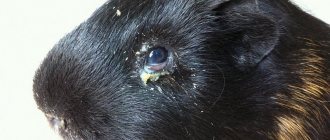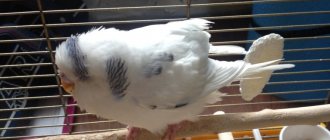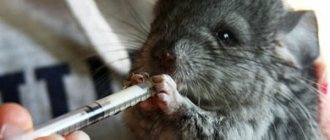03/18/2021 17,507 Guinea pigs
Author: Olga
Shiny coat and clean skin are an integral part of the health of any pet. We can say that wool is generally the main decoration for some breeds of pigs. Therefore, the problem of shedding fur and unhealthy skin has both a medical and an aesthetic aspect. What should a caring owner do if his guinea pig itches and how to understand why he sheds a lot - let’s try to figure it out together!
[Hide]
Why does my pig shed a lot?
Do not forget that molting is a natural process for all animals. Normally, guinea pigs should have it twice a year, in early autumn and late winter - early spring. But the fact is that all animals domesticated by humans, which are constantly kept in approximately the same temperature conditions, may not have pronounced molting.
Instead, the molt seems to be spread out over time and a certain amount of hair falling out can be observed almost constantly. Have you noticed that this amount is clearly increasing, the hair is falling out in clumps or bald spots are appearing on the body? Most likely, this is no longer just an ordinary molt.
Causes
To understand why a pig sheds so much, you need to conduct at least a minimal analysis of its diet, living conditions, and you may need to do some laboratory tests.
The most common causes of severe shedding are:
- Lack of vitamins, especially the deficiency of vitamin C and B vitamins has a clear impact on the condition of the coat.
- The presence of fungal skin diseases. A fungus on the body of a guinea pig, in other words, lichen or dermatophytosis, looks like completely hairless islands of skin. Therefore, if the hair does not fall out evenly, but in specific dotted areas, most likely it is lichen.
- External parasites. In addition to banal fleas, guinea pigs may have ticks, Trixacarus parasites, and lice eaters. But, in addition to molting, they also cause severe itching, and therefore molting in this case is a secondary symptom. Take a closer look at the fallen hair; if its tip is thinned, lice-eaters may be to blame.
- Stress. If an animal has experienced a nervous shock, it may well react to this by rejecting the hair. And for him this could be a move, moving to a smaller cage, a new neighbor, too noisy guests
And then you can watch a video of a guinea pig getting a haircut!
Treatment
First of all, a shedding pig is prescribed a loading dose of vitamin C, supplemented with glucose. They also give vitamin complexes with B vitamins and methionine.
If shedding does not stop, you need to check your pet for parasites. To get rid of fleas and ticks, the same drops are used as for treating cats and dogs, only in a lower concentration. This is why you will need to consult a veterinarian.
Shedding without pathology
Guinea pigs molt in spring and fall. In September, the pet’s body tolerates it without interference, since the summer diet is full of fresh herbs and vegetables. Spring molting occurs in February and requires vitamin supplements in the diet. In addition, juvenile molting occurs in young individuals - a change from “childish” hair to “adult” hair. It is one-time and will not be repeated.
At home, the temperature in the apartment does not change significantly, so the pigs constantly shed a small amount of hair. If the process is not accompanied by alarming symptoms, such prolapse is safe. With age, wool grows in greater quantities. This is due to changes in the body. In addition, older animals spend less time caring for their fur.
Gilts are characterized by “bare” areas of skin behind the ears, provided that there are no peeling or wounds in these areas.
Why does it itch?
The owners of some guinea pigs notice that their pets not only shed a lot of hair, but also itch at the same time. There are cases when the itching is so severe that the animal seriously injures itself.
Causes
Itching in a guinea pig is almost always caused by the activity of ectoparasites; lichen causes itching extremely rarely. At the same time, fleas, lice, ticks, and lice-eaters can parasitize a piglet’s body. A cat flea can also spread to a guinea pig if this pet also lives in your house. Fleas cause severe itching, and crusts may form on scratched areas. With a large number of parasites, anemia may develop.
The most common parasite found in guinea pigs is the Trixacarus mite, otherwise known as the itch mite. The parasite lives up to its name by causing severe, incessant itching. Crusts, scabs, sores, and redness appear at the bite sites. Bacteria can enter wounds, causing severe suppuration and infection. The pig becomes very restless, loses weight, and if there are a large number of parasites, it can twitch convulsively and throw itself at the cage.
Treatment
Before treating mumps, it is necessary to confirm the diagnosis using scrapings. Ivermectin is used to treat mites in guinea pigs. The dosage and number of injections are prescribed by a veterinarian familiar with guinea pigs and the dosages applied to them. Also, to destroy ectoparasites, you can use cat and dog insecticides, in particular, Stronghold drops on the withers for kittens.
Not enough vitamins?
Don't forget to feed your pet with vitamins. The animal itches, has a rash on its skin, and hair falls out. The pet is apathetic and inactive. Sometimes he gets constipated.
If a concerned owner takes a sick pet to the veterinarian, and the tests done do not confirm the presence of any parasites, a diagnosis can be made: vitamin deficiency. Most often it manifests itself in the winter-spring off-season and is associated with a lack of succulent feed containing vitamin C.
What to do in this case? Treatment is extremely simple: you need to increase the portions of such feed. You can also add ascorbic acid to drinking water - no more than 1 mg per liter of liquid.
Experts highly recommend placing a bunch of fresh parsley in the cage, rich in this vitamin and loved by guinea pigs.
also necessary to provide the sick rodent with a quiet and warm place so that the weakened body does not catch a cold, which can lead to pneumonia.
Pododermatitis
Pododermatitis is a fairly common phenomenon among rodents, characterized by a disease of the paws and otherwise called “painful heels.” Most often, the disease affects the guinea pig's hind limbs and hock joint.
Causes
The following factors contribute to the development of pododermatitis:
- Inappropriate conditions for keeping a piglet. Dampness and dirty litter are favorable soil for the proliferation of pathogenic bacteria.
- Excess weight of the pet, it puts additional stress on the paws.
- Low physical activity of the pig.
- Uneven, wire floor in the cage. If every step causes deformation of the animal's foot, it is likely to develop pododermatitis.
- Lack of certain vitamins, in particular vitamin C.
- Claws cut at the wrong time.
An animal affected by pododermatitis will bend its legs and become limited in its movements. Hair falls out on the affected limb, swelling and redness occur.
Then, without appropriate treatment, ulcers and wounds appear on the paw, the animal becomes lethargic and apathetic, and may even cry.
Treatment
It is very important to prevent the development of pododermatitis. That’s why clean the cage on time, use soft material for filler that will not injure your pet’s paws, and trim overgrown claws in a timely manner. If it does develop into pododermatitis, be prepared that it will take quite a long time to treat it. The wounds on the paws are first treated with solutions of chlorhexidine or hydrogen peroxide.
Then Levomekol or Solcoseryl ointment is applied. Antibiotic therapy is sometimes required if the wounds are severe and threaten to develop into blood poisoning. In severe cases, an x-ray may be necessary to ensure the bone is intact.
Fungal diseases
The most common infections in pigs are lichen and dermatophytes. Symptoms of lichen:
- hair falls out in clumps;
- itching;
- skin redness;
- purulent wounds (in later stages);
- dandruff appears.
Ringworm is contagious to people and animals. If this disease is detected in the room, a wet cleaning is carried out and the cage and all objects used by the pet are disinfected.
With ringworm, the animal's skin peels off and bald spots appear on the head. Over time, the disease spreads to the neck, paws and other parts of the body. Infection occurs through low-quality food or items brought from the street. The infection is often “brought” into the house on shoes or clothing.
Nizoral shampoo is suitable for treatment. In just a few procedures, it removes itching and inflammation. Apply it to sore spots for 5-7 minutes, then wash off with warm water. It is not recommended to bathe a pig entirely - they do not like water treatments. You can also use Fungoterbin and Thermikon creams (one percent). As a last resort, you can purchase Castellani or Fukortsin.
New growths on the skin
Tumors in guinea pigs are rare, but, of course, sometimes it is the neoplasm that causes a visit to the veterinary clinic.
What could it be?
As a rule, the owner may suspect a tumor in his guinea pig if he notices a strange lump on the pet’s body or a non-healing wound. However, the neoplasm is not always malignant. This may be an abscess - a purulent capsule resulting from an injury. A lipoma, a benign formation consisting of fat cells, can also develop on the body of a guinea pig. Lipoma grows slowly and does not pose a threat to the pet’s life; it looks like a lump with moving contents.
In principle, a benign tumor can be distinguished by its growth rate and structure. The benign formation grows slowly and is located, as it were, on a stalk, at some distance from the skin. Cancer most often looks like an unhealed wound rather than a lump. It affects the skin on the paws, less often on the back or sides.
Treatment
To treat an abscess, Vishnevsky or Ichthyol ointments are used. They contribute to the rapid “ripening” of a purulent wound, which, after opening, is cleaned of pus and disinfected. Tumors, of course, need to be removed surgically. Moreover, it is also advisable to remove a benign lipoma, because there is always a risk that it will develop into a malignant liposarcoma. With timely surgical intervention, 70% of cases result in a complete cure.
Causes of nasal congestion
Congestion is when the nose becomes stuffy and sore. Minor illnesses are the most common causes of nasal congestion. For example, colds, flu, and sinus infections can cause nasal congestion. Congestion associated with the disease usually improves within one week.
The main cause of nasal congestion is infection, and the common cold is the most common type. When you have a cold, you have a viral infection, and such conditions do not respond to antibiotics, so they must run their course. A cold usually lasts about a week, give or take a few days. With over-the-counter medications, plenty of fluids, and rest, you should begin to feel better within a few days. The average child will catch up to six colds per year, and the average adult will catch up to three colds per year. A sinus infection (sinusitis) is the most common type of bacterial infection in the nose, and it can also lead to nasal congestion.
Allergic rhinitis, caused by allergies, is the second most common cause of nasal congestion. An allergy is an inflammatory reaction to an environmental pollutant (grass, dust, pollen, hay fever, mold or pet dander).
Another cause of nasal congestion is vasomotor rhinitis, and it occurs when the nasal passages become inflamed (swollen.) During an allergy attack or reaction, the blood vessels become larger and cause the membranes in the nose to become blocked, leading to nasal congestion. Avoiding respiratory irritants usually helps with this form of nasal congestion.
The fourth cause of nasal congestion is structural abnormalities, which are usually noticed in childhood. Although adults can also develop structural abnormalities, they are most often the result of injury later in life. Surgery is often the only option for correcting structural abnormalities of the nasal passages. Over-the-counter allergy medications do provide some relief from persistent nasal congestion.
If congestion lasts longer than one week, it is often a symptom of an underlying health problem. Some explanations for long-term nasal congestion may include:
- allergy
- hay fever
- benign growths called nasal polyps, or benign tumors in the nasal passages
- chemical exposure to irritants
- environment
- long-term sinus infection known as chronic sinusitis with
- deviated septum
Nasal congestion can also occur during pregnancy, usually at the end of the first trimester. Hormonal fluctuations and increased blood flow that occur during pregnancy can cause this nasal congestion.
These changes can affect the nasal membranes, causing them to become inflamed, dry, or bleeding.
Video “Cutting a guinea pig’s claws”
To ensure that your pet pig does not have pododermatitis, you should trim its claws on time, and the video will further demonstrate how to do this.
Sorry, there are no surveys available at this time.
Was this article helpful?
Thank you for your opinion!
The article was useful. Please share the information with your friends.
Yes (100.00%)
No
X
Please write what is wrong and leave recommendations on the article
Cancel reply
Rate the benefit of the article: Rate the author ( 5 votes, average: 4.80 out of 5)
Discuss the article:
Treatment and prevention
Don't panic if you find parasites in a rodent's fur. Today there are a lot of available drugs to kill pests. Remedies for lice for guinea pigs come in the form of:
- sprays, drops;
- emulsions, shampoos;
- collars and powders.
Spray
You can effectively combat the pest using sprays. They are created on the basis of insecticidal components and have a simple method of application. It is enough to spray the rodent’s fur with the solution, then rub it over the entire surface of the skin with massage movements. Most often, just one spray treatment is enough to completely rid your guinea pig of parasites. An example of such a product is Frontline spray.
Spray Frontline
Drops
Treatment for lice in guinea pigs is also carried out with drops containing an insecticide. The drug helps to get rid of not only lice-eaters, but also mites, lice and other skin parasites. The solution is dripped onto the spine in the neck area so that the rodent cannot reach it. Such means are the most effective, as they not only destroy lice-eaters, but also prevent their re-spread. Drops of the Stronghold, Bars, Advantage or Green Fort brands are in particular demand among consumers.
Emulsions
Emulsion is another cure for lice. The concentrated suspension is diluted with water in accordance with the manufacturer's recommendations. It is used to process animal fur. Many consumers prefer the drug Neostomozan.
Shampoos
Shampoos are a safer way to treat guinea pigs. It is preferable to use such detergents for preventive purposes. Since it is not always possible to achieve complete destruction of insects after one application. Lugovoy, Lesnoy or Fitoelita shampoos are very popular among consumers.
Collars
Collars not only get rid of pests, but also prevent re-infestation of lice-eaters in guinea pigs. The disadvantage of this accessory is the possibility of an allergic reaction and irritation in the pet.
Collar Celandine
Powder
A powdered product in the form of powder can not only get rid of pests, but also cure the inflammatory process on the skin, and also reduce the feeling of itching. The rodent's body is sprinkled with powder, trying to rub it into the skin as much as possible. The effect of the drug lasts for one and a half weeks.
To get rid of lice, it is necessary to treat not only the guinea pig, but also the cage in which it is kept. A similar procedure should also be applied to household items with which the animal comes into contact. To do this, you can use Butox 50 solution.











